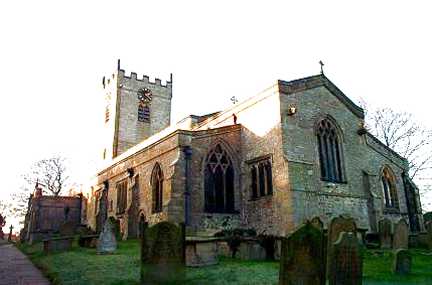by Lauren Gilbert
It’s important to remember that, once upon a time, saints were declared locally. Many have not been canonized officially. St. Alkelda seems to have been one of those saints. St. Alkelda seems to have been known only in the Middleham area of Yorkshire. Her name is associated with two churches: St. Mary and St. Alkelda’s Church in Middleham, and St. Alkelda’s in Giggleswick, both of which are still open and serving their parishes.
 |
| Middleham: The Collegiate Church of St. Mary and St. Alkelda, by Bill Henderson, 2002. Wikimedia Commons |
Alkelda’s name may have been derived “haeligkeld” an Old English word meaning a holy well or spring. It is worth noting that there is a well in Giggleswick, called the Ebbing and Flowing Well, as well as a St. Alkelda’s Well at Middleham which has apparently been blocked up due to construction in the 1950’s. The church in Middleham has a stained glass window showing her death by strangulation (oddly, she was depicted as smiling). St. Alkelda was supposedly buried beneath the nave of St. Mary and St. Alkelda’s Church in Middleham. The well at that church, when water was accessible, was supposed to have healing qualities. There were associations between a well at Giggleswick and the healing of eye problems, but whether it was the Ebbing and Flowing Well or a different well does not appear to be known.
 |
| St. Alkelda's Church, Giggleswick, by Humphrey Bolton |
St. Alkelda’s feast day was celebrated March 28 (although there is also a reference to November 5). There is no reference to St. Alkelda in any of the versions of The Lives of the Fathers, Martyrs and Principle Saints by Alban Butler that I consulted, nor was she shown on the list of saints demoted and removed. However, I did find a reference to her as a pre-schismatic saint in the Eastern Orthodox Church who was martyred by the Danes, with a feast day of March 27. She is not shown on the current Eastern Orthodox calendar.
St. Mary and St. Alkelda Church in Middleham had a strong connection to Richard III. Amy License, in chapter 9 of her biography of Anne Neville, indicated that, when in residence in Middleham Castle, Richard and Anne attended that church and, as Duke and Duchess of Gloucester, named various stalls for their favourite saints, including St. George and St. Barbara (military saints, probably for Richard) and St. Winifred (probably for Anne). Ms. License also indicated that Richard had planned to establish a chantry college at St. Mary and Alkelda, to say prayers for the salvation of the souls of his family. In 1478, Richard III received a grant to elevate St. Mary and Alkelda to the status of a college church, which would have had a dean and six secular priests. This did not come to pass due to Richard’s death.
Obviously, there are many questions about whether or not Alkelda lived. There are claims that the details, such as they are, are inventions. Nevertheless, St. Mary and St. Alkelda Church went through extensive renovation in 1878, at which time a primitive stone coffin containing ancient remains was discovered in the vicinity of the area tradition indicated St. Alkelda was buried. A doctor declared these remains to be female. A plaque was mounted on a pillar near the spot indicating that the remains of St. Alkelda, patron saint of the church, had been found near there. Research by Dr. Heather Edwards threw into question the derivation of the name Alkelda, preferring the medieval Alchild which fits a 7th-8th century lifetime, and discounts the idea of the martyrdom. Others prefer a 9th-10th century date, which fits the derivation of Alkelda from the Old English term. Regardless of the date, here seems to be a conviction that Alkelda was a real person, probably not a princess but definitely a religious, who was locally venerated in the Middleham area.
Sources include:
License, Amy. ANNE NEVILLE Richard III’s Tragic Queen. 2013: Amberly Publishing, Stroud. (Kindle version)
GoogleBooks. NOTES AND QUERIES: A Medium of Intercommunication for Literary Men, General Readers, Etc. Sixth Series-Volume Twelfth. July-December 1885. London: Office, 22, Took’s Court, Chancery Lane, E.C. HERE.
British History Online. “Houses of Benedictine monks: Priory of St John Baptist & St Godric, Finchale.” From A History of the County of Durham: Volume 2, ed. William Page (London, 1907), pp. 103-105 HERE.
North Craven Heritage Trust. “Sacred Landmarks and Landscapes in North Craven:
St Alkelda re-visited, holy wells and south-side side crosses” by Kathleen Kinder. Journal 2015. HERE. “St. Alkelda” by Michael Slater. Journal 2008. HERE.
18th Century Collections on line. “The History and Antiquity of the county palatine, of Durham” by William Hutchison. 1732-1814. HERE.
Jervaulx Churches.”St. Alkelda.” (No author or post date shown.) HERE
Britannia.com. “St. Alkelda (Died C AD 800).” (No author or post date shown.) HERE.
Project Gutenberg. Butler, Alban. The Lives of the Fathers, Martyrs and Principal Saints. January-March. 1895: Archbishop’s House, New York. HERE.
Wikipedia. “March 27: Eastern Orthodox Liturgics.” (No author shown.) Last modified March 3, 2017. HERE.
Britain Express. “Finchale Priory” by David Ross. (No post date shown.) HERE.
Wikimedia Commons. St. Mary’s and St. Alkelda’s Church. HERE. ; St. Alkelda’s Church, Giggleswich. HERE.
~~~~~~~~~~~~~
Lauren Gilbert lives in Florida with her husband. Her first published book, HEYERWOOD, A Novel, was released in 2011, and her second, A Rational Attachment, is due out in 2017. Please visit her website HERE for more information and current events!

Lovely post!
ReplyDeleteThank you, Samantha! I'm so glad you enjoyed it.
DeleteVery interesting - I hadn't come across St Akelda before.
ReplyDeleteI think the creation of "localised" saints like Akelda is rather reminiscent of the creation of "localised" gods in Roman Britain - there are lots of them, mostly known only by a single inscription. This ancient urge to have something/someone specifically rooting for your particular district/town/village may even survive in the modern day practice of creating mascots!